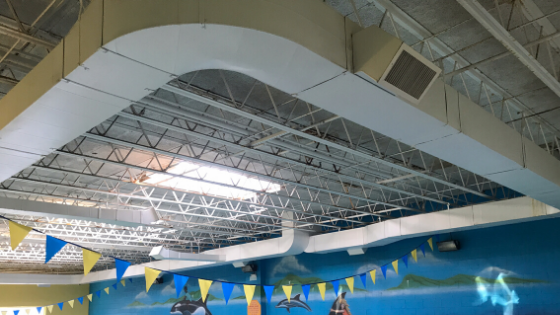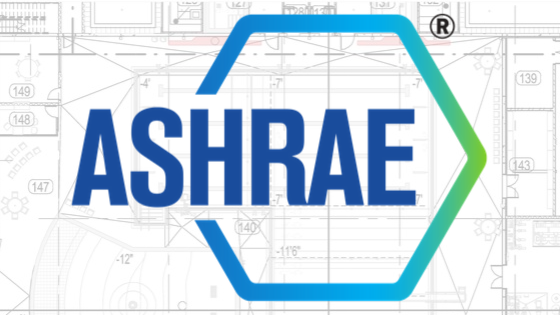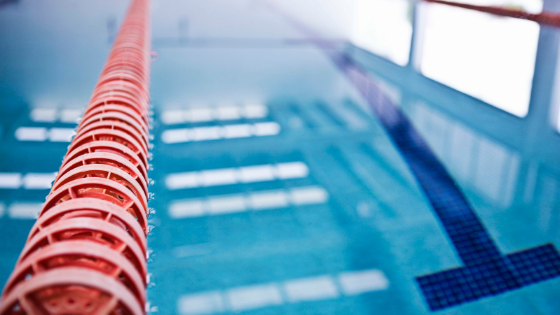Understanding Source-Capture Exhaust
Trichloramine, trihalomethanes and other noxious disinfection byproducts (DBPs) that off-gas from swimming pools are not your ordinary airborne contaminants. These substances–when condensed with vapor in the natatorium–tend to have a low, corrosive pH, and a vicious appetite for destruction. Fortunately, these same DBPs behave in a predictable and therefore controllable way.
Because we know how these gases behave, the most effective way we know of to remove them from an indoor swimming pool is using source-capture exhaust. This article will explain what that entails.
Source-Capture Exhaust
Most natatoriums designed within the ASHRAE 62.1 standard will exhaust anywhere from 15-25% of the total air circulated. And as we have discussed in another article, most indoor pools exhaust from the return air flow. This is beneficial for energy efficiency, but not great for indoor air quality (IAQ). In short, how does an exhaust fan in the pool dehumidification unit (PDU) or return duct distinguish between contaminated air and fresh air?
It cannot.
So most pools exhaust 15-25% of...well, whatever air gets drawn into the return(s). It's not an effective means of clearing the natatorium of harmful chloramines and other DBPs. Enter source-capture exhaust.
Target and Remove
Source-capture is exactly what it sounds like. It's simply a method that targets airborne contaminants in question, and captures them at their source. In a kitchen, a range hood fan is a good example of this. It is designed to exhaust steam, smoke, and high heat that rises from the grill or stove. Source-capture is required in commercial kitchens, for somewhat obvious reasons. Can you imagine how miserable it would be in a kitchen if they had no direct capture of smoke and steam? It would be a health hazard.
Sounds pretty familiar...a known health hazard in the form of airborne contaminants in an enclosed space...perhaps an indoor swimming pool?
Related: Indoor Pool Air Quality Resources
While smoke and steam rise and are directly captured by a range hood, airborne chloramines and other DBPs are heavier than oxygen. They stay low in the room. Not quite as convenient as a kitchen stove or grill, but predictable nonetheless. Since natatoriums are far larger than a commercial kitchen cooktop, here are some helpful tips for effective source-capture exhaust. If your natatorium does not already meet the following criteria and you have an air quality issue, perhaps we can help.
1. Get as close to the source as possible
The primary sources of airborne chloramines are the swimming pool itself and the wet deck. We need to get as close to these sources as possible, without obstructing access for people. Paddock Pool Equipment Company invented the first source-capture exhaust system for indoor swimming pools, called The Paddock Evacuator®. Here's a video about Queens University, who has an Evacuator source-capture exhaust built right into the pool gutter itself. It's hard to get closer to the source of chloramines than that.
Gutter Evacuators are proactive, really only available for when the pool is first being built (unless it's a major renovation and gutter replacement). Another proactive Evacuator system is the in-deck Evacuator. It looks just like a deck drain, and exhausts air through it as well. This is great for clearing wet decks and pool surfaces, and is an option for non-gutter pools, like those with skimmers.
For existing natatoriums, however, Evacuator benches are the most practical option. They not only provide seating, but exhaust chloramine-laden air, as close the the source as it can get. Not quite as good as a gutter or deck drain, but it does the job.
2. Supply airflow must match the exhaust
If source-capture is the method of removal, the chloramines must be brought to it. It's an exhaust system after all, and it will not pull chloramines all the way across a pool. They need to be swept by well-designed supply airflow. Most natatorium air quality renovations we do involve some sort of modification to improve supply airflow and design. The objective, is not just to clear the room of harmful, heavy chloramines. It's to consistently clear the room, 24/7. Chloramines are constantly being produced and off-gassed, so the source-capture exhaust must keep up.
If the supply does not match the needs of the exhaust, it won't work well.
3. Stay in balance
Finally, keep in mind that the natatorium should be slightly negatively pressured. This means we exhaust about 10% more than we introduce through the PDU as fresh air. This negative pressure keeps the pool "in the pool". Disrupting this balance one way or the other can be problematic. We have seen pools go positively pressured, which pushes chloramines into locker rooms, offices and the gymnasium (talk about costly equipment damage!) On the flip side, we have also been to pools that were not properly balanced after installing the Evacuator system, and opening the door took strength to fight the vacuum. Neither is desirable, so keep the natatorium in that ~10% negative balance.
Traditional exhaust
One of the most common mistakes in natatorium design, as outlined in this article, is misplaced exhausts. Specifically, we see a lot of natatoriums with ceiling exhausts. Now, from a dehumidification and energy perspective, that makes some sense...warm, humid air rises and expands. But chloramines don't. They stay low, and should be source-captured.
Source capture exhaust allows bad air to be mostly separated from good, clean air. It can prevent corrosive chloramines from rotting the PDU from the inside out, and prevents the compounding effect of bad air during swim practice or meets. Ceiling exhaust fans have no chance of throwing away chloramines, so they're only getting rid of the best air in the space.
Just some thoughts to keep in mind. If you're working on a new pool or an existing one, we are here to help. Just contact us if you want to learn more. Thanks for your time.

 By
By



